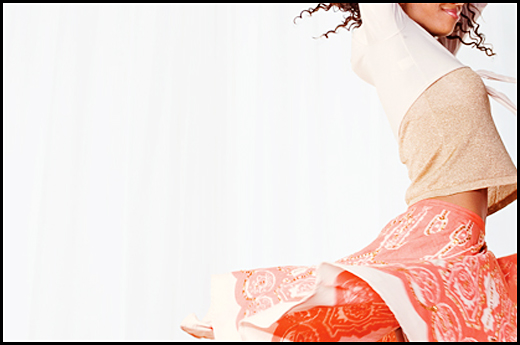by guest blogger Maya Rodale, writer of historical tales of true love and adventure
I’ve been thinking a lot about clothing lately—more than usual—and not just when I am standing in front of my closet trying to figure out what to wear. I recently read three wildly different books that had something intriguing to say about women and fashion.
Caitlin Moran succinctly says what I have always known to be true in her brilliant and hilarious book, How to Be a Woman: “Her outfit is the first thing she says before she even opens her mouth.”
I’ve long believed that dressing was its own unspoken language, conveying volumes to the world about the wearer’s values, point of view, and identity. Which caused problems in the house when I needed to craft exactly the right message with my outfit and my mother yelled to hurry the heck up and just whatever I had on, we had to go already!
Shortly after reading How to Be a Woman, I read Infidel, which is the stunning autobiography of Ayann Hirsi Ali. In it she details her upbringing in strict Muslim countries before fleeing an arranged marriage, moving to Holland, and eventually joining the government there.
Below is a scene with two Ethiopian girls, after she’s just arrived. Ayaan is in the process of shedding her strict Muslim attire—and her strict Muslim beliefs:
“Take off the scarf and long skirt! You’re pretty…Why do Muslims have to cover themselves….?”
“…Don’t you have any shame? What are you hoping to achieve walking around undressed? Don’t you know how it affects men?” [says Ayaan]
“I wear these skirts because I like having pretty legs,” said Mina. “They won’t be pretty for long, and I want to enjoy them…if anyone else enjoys them, so much the better.”
“But if men see women dressed like you are now, with your arms bare and everything naked, then they will become fused and sexually tempted,” I told them. “They will be blinded by desire.”
The girls began laughing, and Mina said, “I don’t think it’s really like that. And you know, if they get tempted, that’s not such a big deal.”
By then I was wailing because I could see what was coming, but I said, “But they won’t be able to work, and the buses will crash, and there will be a state of total fitna!”
“So why is there not a state of total chaos everywhere around us, here, in Europe?” Mina asked.
It was true. All I had to do was use my eyes. Europe worked perfectly, every bus and clock of it…. “I don’t know,” I said helplessly. “It must be because these are not really men.”
“Oh? They are not really men, these big strong blond Dutch workers?”
…We Muslims were always boasting about something or other, but our whole culture was sexually frustrated. And who on earth did I think I was to personally wreak fitna on the world?
Behold, clothing as values, as identity, protection for the wearer and/or the viewer, something to attract or repel—a bolt of fabric standing between world peace and epic disaster. It’s not just a shirt. There can be serious consequences for wearing the “wrong” thing.
Which is why deciding what to wear can be such an ordeal for some people. I think Caitlin Moran says it best—again: “When a woman says, ‘I have nothing to wear!’ what she really means is, ‘There is nothing here for who I’m supposed to be today.'”
Which brings me to one more book: I Have Nothing to Wear! by Jill Martin and Dana Ravich. This one is really about how to organize your closet so that all the clothes in your wardrobe are not for who you are supposed to be but for who you truly, happily, comfortably are. The idea being that when you feel good—when you feel like you are who you are supposed to be today, inside and out—you don’t hold back from life experiences because you feel like you don’t have the right statement, identity, or message to wear.
My husband seems to have solved this problem in a Steve Jobs kind of way. He crafted one outfit that conveys exactly the message he wants to send: white button-down shirt with the sleeves rolled up, dark Levi’s, cowboy boots, English accent. He bought duplicates of everything and wears this outfit—comfortably—every day.
 Maya Rodale is the author of multiple historical romance novels, as well as the nonfiction book Dangerous Books for Girls: The Bad Reputation of Romance Novels, Explained. She has a master’s degree from New York University and lives in Manhattan with her darling dog and a rogue of her own. Her latest book is The Tattooed Duke. Learn more at mayarodale.com
Maya Rodale is the author of multiple historical romance novels, as well as the nonfiction book Dangerous Books for Girls: The Bad Reputation of Romance Novels, Explained. She has a master’s degree from New York University and lives in Manhattan with her darling dog and a rogue of her own. Her latest book is The Tattooed Duke. Learn more at mayarodale.com





Quote: “So why is there not a state of total chaos everywhere around us, here, in Europe?” Mina asked.
Is this world not in chaos?
It’s called “organized” chaos.
I have some interesting commentary on Google+ on wearing the veil that was catalyzed by a political cartoon. Wearing the veil is a regional, not muslim custom as you will find, for example, eastern orthodox women and the Jewish women of the same regions going veiled too in the more conservative factions of local cultures.
My mother’s mother’s family are Bukharan Jews (and her father was a Polish Jew) and my father’s family are from all over the silk road but came to this country through eastern Europe, and he was a Unitarian Universalist minister.
But I am possibly more culturally sensitive to the cultures of the ‘Stans than most in this country. Certainly, when we went to war in Afghanistan, I at least knew more than many of the news outlets who reported on national television that we were at war with a middle eastern country!
Yes, fashion is a vocabulary, but it is a poetic one that is hard to translate directly, out of the complicated context in which it is born. You can’t just transplant a profoundly influential cultural poem without explaining the metaphors with much more text than is involved in the poem itself — the poem is a distillate of the experience of the culture.
If you think you understand the vocabulary or nuances of the wearing of the hijab, the veil, even of the burqa which is the tent-like thing that covers head-to-toe, in some snap judgement — then you are guilty of shutting off an entire score of cultures on a prejudicial and lazy basis.
It’s not a good thing. It’s neither all bad. Like most things in life, it’s more complicated, rich, and interesting at its base than you would think at first glance.
And it’s also an issue being used as a pawn in women’s rights, in nationalist propaganda, in anti-religious propaganda, and in anti-immigrant propaganda. Do you want to step in those waters unaware?
https://plus.google.com/100520148877423056661/posts/fMwkoooDYVG
https://plus.google.com/101371184407256956306/posts/M79NRkPUbGE